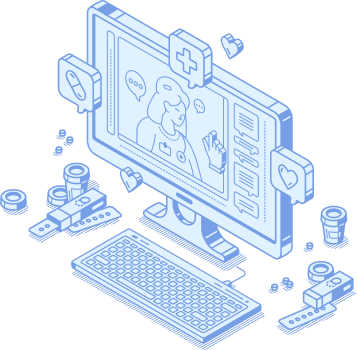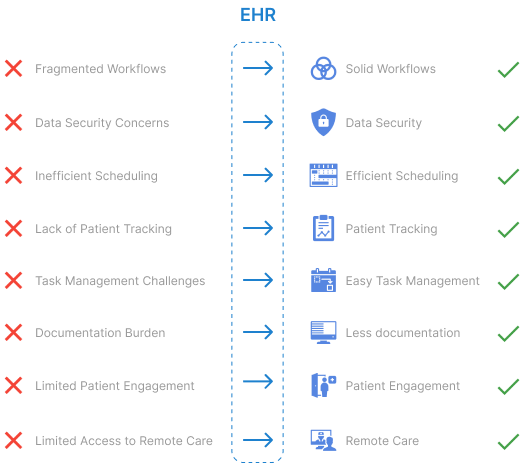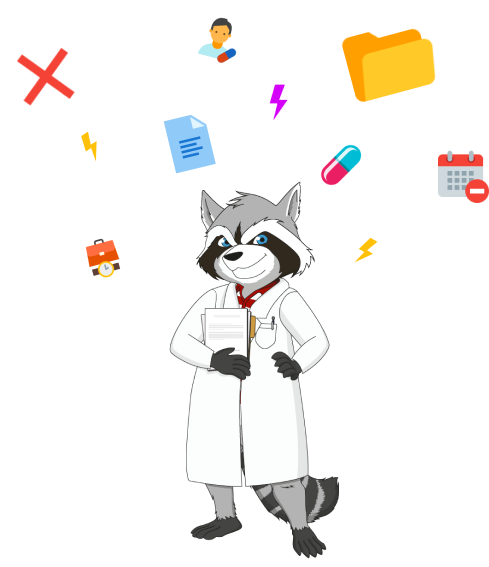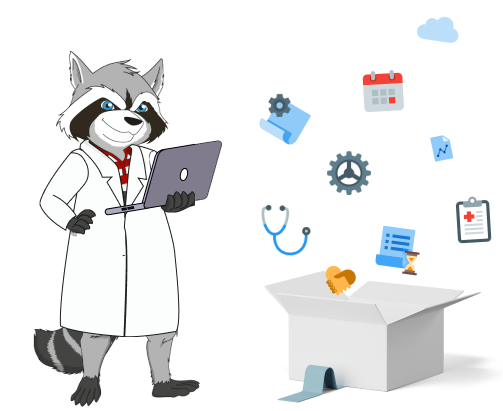Electronic Health Record Systems (EHR)
Electronic Health Record Systems (EHR) play a crucial role in modern healthcare, supporting clinical workflows, ensuring patient data protection, and enhancing overall patient care. With comprehensive modules and functionalities, EHR systems streamline scheduling, patient tracking, task assignment, clinical documentation, and more. Additionally, they comply with HIPAA regulations and enable patient engagement through portals and telemedicine modules.

Problem
Healthcare providers face numerous challenges in managing clinical workflows, protecting patient data, and ensuring efficient communication and coordination among care team members. These challenges can hinder the delivery of high-quality patient care and impact operational efficiency. Some specific pain points include:
- Fragmented Workflows: Healthcare organizations often operate with fragmented workflows, relying on manual processes, paper-based records, and disconnected systems. This leads to inefficiencies, delays, and increased administrative burden.
- Data Security Concerns: With the increasing digitization of patient records, healthcare providers must ensure the confidentiality, integrity, and availability of sensitive patient information. Compliance with regulations, such as HIPAA, adds complexity to data protection requirements.
- Inefficient Scheduling: Managing appointments and optimizing schedules can be a time-consuming and error-prone process. Healthcare practices need a streamlined solution that integrates with their EHR system to improve scheduling accuracy and reduce no-shows.
- Lack of Patient Tracking: Without a centralized system for patient tracking, front desk staff struggle to manage patient flow, leading to longer wait times, confusion, and potential bottlenecks in the care delivery process.

- Task Management Challenges: Assigning and prioritizing tasks among care team members can be challenging, resulting in miscommunication, delays, and potential gaps in care delivery. A solution is needed to streamline task assignment, track progress, and ensure accountability.
- Documentation Burden: Healthcare providers face significant documentation requirements, including generating clinical notes, treatment plans, and progress reports. The manual process of creating and managing these documents can be time-consuming and prone to errors.
- Limited Patient Engagement: Patients desire greater involvement in their healthcare journey, including access to their medical information, convenient appointment scheduling, and the ability to participate in decision-making. Existing systems may not adequately support patient engagement initiatives.
- Limited Access to Remote Care: With the growing demand for telemedicine and remote consultations, healthcare providers need a solution that enables secure and seamless virtual visits, expanding access to care for patients.

Addressing these challenges requires a comprehensive Electronic Health Record System (EHR) that offers robust modules and functionalities to streamline workflows, enhance data security, improve scheduling, enable patient tracking, optimize task management, facilitate documentation, empower patients, and support telemedicine capabilities.
Solution
The Electronic Health Record System (EHR) is a comprehensive cloud-based medical records service designed to streamline patient visits, enhance documentation accuracy, and set healthcare practices up for future success. Whether you're a small practice or a large healthcare system, the EHR system intuitively organizes patient data and supports the existing workflow in your clinic. It ensures patient data protection and compliance with HIPAA regulations, while also providing modules for schedule management, patient tracking, task assignment, clinical documentation, reports generation, patient portal, and telemedicine capabilities. With the EHR system, you can automate repetitive tasks, improve operational efficiency, and deliver high-quality care to your patients.

Feature Highlights

The EHR system supports the workflow already present in your clinic, ensuring seamless connectivity between all members of the patient care environment. It optimizes the flow of patient information, improving collaboration and coordination among healthcare professionals.

The EHR system prioritizes the security and privacy of patient data. It employs robust measures to ensure the confidentiality, integrity, and availability of sensitive health information, complying with HIPAA regulations and industry best practices.

The EHR system integrates with a scheduling system, providing the necessary data to optimize appointment scheduling and manage the clinic's agenda efficiently. It helps reduce scheduling conflicts, improve patient flow, and maximize the utilization of resources.
With the EHR system, you can effectively manage patient status throughout their visit. It provides front desk personnel with real-time updates on patient rooming, sends wait notifications to patients, and offers insights into peak times and patient flow patterns for better resource allocation.

The EHR system facilitates the assignment, delegation, and transmission of tasks among healthcare professionals. It ensures the seamless flow of work, tracks task completion, and enables prioritization to ensure timely and appropriate care delivery.

The EHR system offers robust tools for generating accurate and comprehensive clinical documentation. It enables healthcare professionals to create patient-specific care plans, follow organizational guidelines and protocols, and streamline the entry of orders. This functionality enhances communication, decision-making, and continuity of care.

The EHR system empowers healthcare professionals to generate various patient-specific reports. These reports can include problem lists, medication lists, encounter reports, clinical notes, treatment plans, progress notes, and more. Templates are customizable based on specialty and visit type, allowing for efficient and standardized reporting.

The EHR system provides a patient portal where patients can actively engage in their own care. Patients can access their recent visit activity, track symptoms, schedule follow-up appointments, receive automated appointment reminders, participate in virtual visits, make online payments, request medication refills, and more. The patient portal enhances patient-provider communication and empowers patients to take an active role in their healthcare journey.

The EHR system incorporates a telemedicine module that enables virtual consultations and remote patient monitoring. This module facilitates secure video conferencing, remote examination, and secure data exchange, expanding access to care and improving patient convenience and satisfaction.
Benefits & Impact

The EHR system streamlines clinical workflows, eliminating manual processes and reducing paperwork. This improves efficiency, enabling healthcare professionals to focus more on patient care and less on administrative tasks. It optimizes the flow of information, enhances collaboration, and minimizes errors, leading to improved productivity and time savings.

With the EHR system, healthcare professionals have quick access to comprehensive patient information, including medical history, allergies, medications, and test results. This promotes informed decision-making, enhances care coordination, and reduces the likelihood of medical errors. The system also supports evidence-based practices, ensuring that healthcareproviders deliver the highest quality of care to patients.


The EHR system prioritizes patient data protection, complying with stringent security measures and privacy regulations. It safeguards sensitive health information, preventing unauthorized access and ensuring confidentiality. This instills patient trust and confidence in the healthcare organization, leading to improved patient satisfaction and loyalty.

The EHR system simplifies the process of generating clinical documentation and reports. It automates documentation tasks, reduces manual errors, and offers customizable templates that align with specialty and visit type. This improves the accuracy and completeness of documentation, enhances communication among healthcare professionals, and facilitates better care coordination.

The EHR system includes a patient portal that empowers patients to actively participate in their own care. Patients can access their health records, schedule appointments, communicate with their healthcare providers, and engage in virtual visits. This fosters patient engagement, improves communication, and enables patients to take a more proactive role in managing their health.

The EHR system eliminates the need for paper-based records, reducing costs associated with printing, storage, and retrieval of physical files. It also streamlines administrative processes, such as billing and claims management, leading to faster reimbursement and improved financial performance. These cost savings and operational efficiencies contribute to the overall financial sustainability of healthcare organizations.

The EHR system is designed to scale with the growing needs of healthcare organizations. It supports interoperability, allowing seamless exchange of patient information between different healthcare systems and providers. This promotes continuity of care, facilitates care transitions, and enables comprehensive and coordinated healthcare delivery.

The implementation of the EHR system brings numerous benefits to healthcare organizations, healthcare professionals, and patients alike. It enhances efficiency, improves patient care quality and safety, ensures data security and privacy, and empowers patients to actively participate in their own healthcare journey. Ultimately, the EHR system drives positive impacts on healthcare delivery, patient outcomes, and overall organizational performance.
Conclusion
The Electronic Health Record System (EHR) is a transformative solution that brings significant advancements to healthcare delivery and management. By leveraging its comprehensive features and capabilities, the EHR system enhances workflow efficiency, improves patient care and safety, ensures data security and privacy, streamlines documentation and reporting processes, fosters patient engagement, and drives cost savings and operational efficiency.
By adopting the EHR system, healthcare organizations can experience a wide range of benefits. These include increased productivity, reduced errors, improved care coordination, and enhanced patient satisfaction. With quick access to comprehensive patient information, healthcare professionals can make well-informed decisions and provide personalized care.
Furthermore, the EHR system contributes to the digital transformation of the healthcare industry, enabling interoperability and seamless exchange of patient data. It lays the foundation for future advancements in healthcare technology and supports the adoption of emerging trends such as telemedicine and patient portals.
In the ever-changing healthcare landscape, the EHR system is crucial for healthcare organizations to remain competitive, deliver high-quality care, and comply with regulatory requirements. By optimizing clinical workflows and enhancing patient outcomes, the EHR system empowers healthcare professionals to focus on delivering exceptional patient care.
With its extensive features and robust data management capabilities, the EHR system serves as a powerful tool that enables healthcare organizations to thrive in the digital age. It unlocks new possibilities, improves patient outcomes, and plays a pivotal role in shaping the future of healthcare.